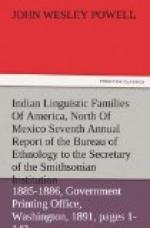[Footnote 49: Sir William
Johnson in Parkman’s Conspiracy of
Pontiac, app.]
[Footnote 50: Bancroft, Hist. U.S.]
[Footnote 51: Ramsey, Annals of Tennessee, 1853.]
[Footnote 52: Ramsey, Annals of Tennessee, 1853.]
[Footnote 53: Blount
(1792) in Am. State Papers, 1832, vol. 4,
p. 336.]
The whole region of West Virginia, Kentucky, and the Cumberland River region of Tennessee was claimed by the Iroquois and Cherokee, but the Iroquois never occupied any of it and the Cherokee could not be said to occupy any beyond the Cumberland Mountains. The Cumberland River was originally held by the Shawnee, and the rest was occupied, so far as it was occupied at all, by the Shawnee, Delaware, and occasionally by the Wyandot and Mingo (Iroquoian), who made regular excursions southward across the Ohio every year to hunt and to make salt at the licks. Most of the temporary camps or villages in Kentucky and West Virginia were built by the Shawnee and Delaware. The Shawnee and Delaware were the principal barrier to the settlement of Kentucky and West Virginia for a period of 20 years, while in all that time neither the Cherokee nor the Iroquois offered any resistance or checked the opposition of the Ohio tribes.
The Cherokee bounds in Virginia should be extended along the mountain region as far at least as the James River, as they claim to have lived at the Peaks of Otter,[54] and seem to be identical with the Rickohockan or Rechahecrian of the early Virginia writers, who lived in the mountains beyond the Monacan, and in 1656 ravaged the lowland country as far as the site of Richmond and defeated the English and the Powhatan Indians in a pitched battle at that place.[55]
[Footnote 54: Schoolcraft, Notes on Iroquois, 1847.]
[Footnote 55: Bancroft, Hist. U.S.]
The language of the Tuscarora, formerly of northeastern North Carolina, connect them directly with the northern Iroquois. The Chowanoc and Nottoway and other cognate tribes adjoining the Tuscarora may have been offshoots from that tribe.
PRINCIPAL TRIBES.
Cayuga.
Cherokee.
Conestoga.
Erie.
Mohawk.
Neuter.
Nottoway.
Oneida.
Onondaga.
Seneca.
Tionontate.
Tuscarora.
Wyandot.
Population.—The present number of the Iroquoian stock is about 43,000, of whom over 34,000 (including the Cherokees) are in the United States while nearly 9,000 are in Canada. Below is given the population of the different tribes, compiled chiefly from the Canadian Indian Report for 1888, and the United States Census Bulletin for 1890:




